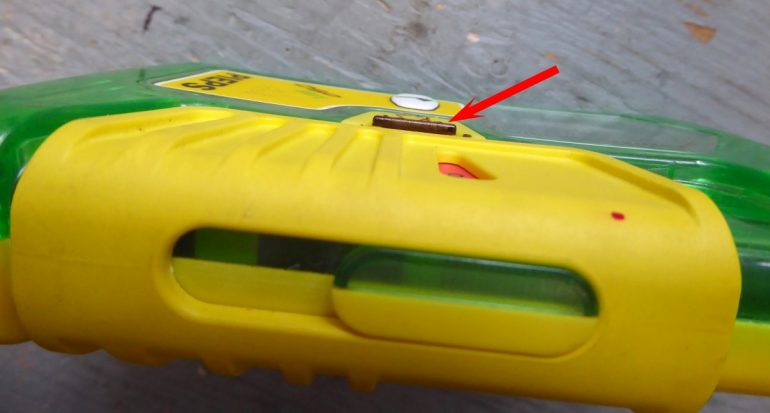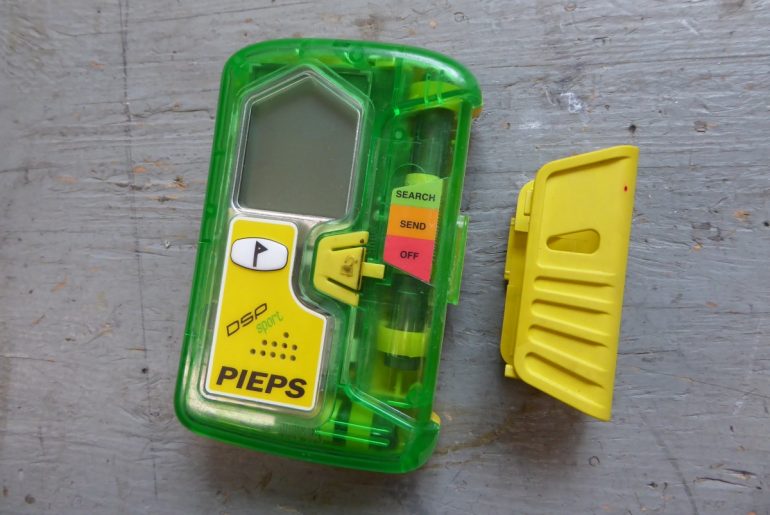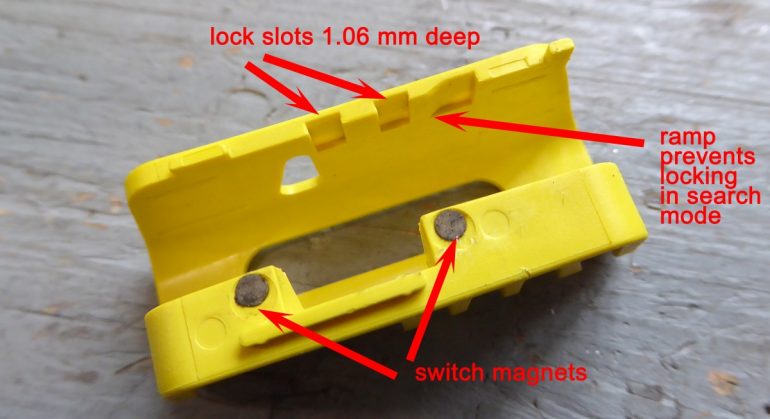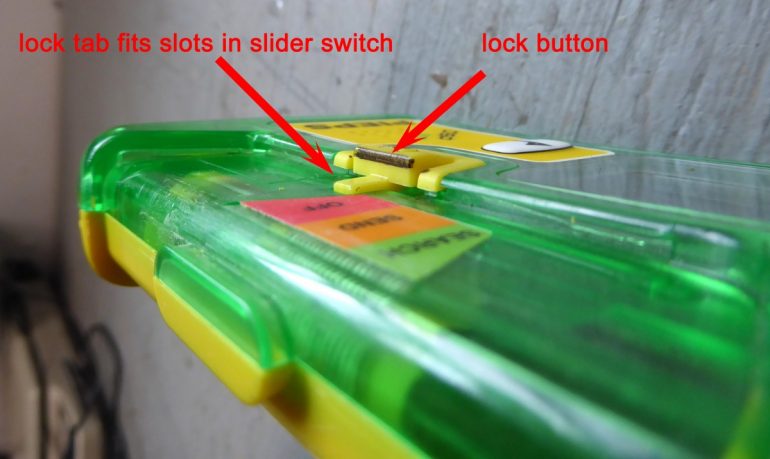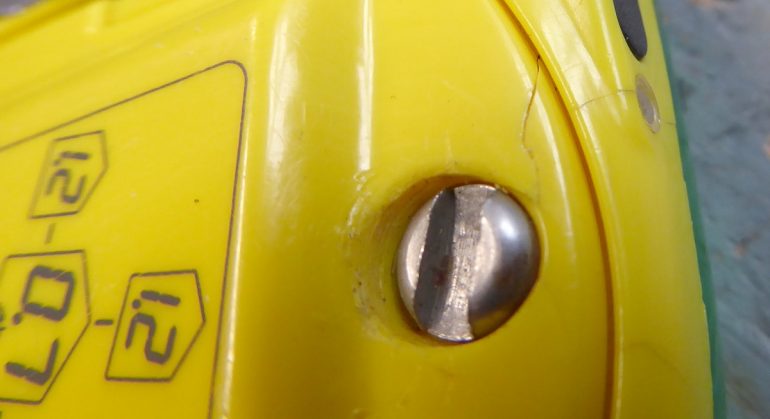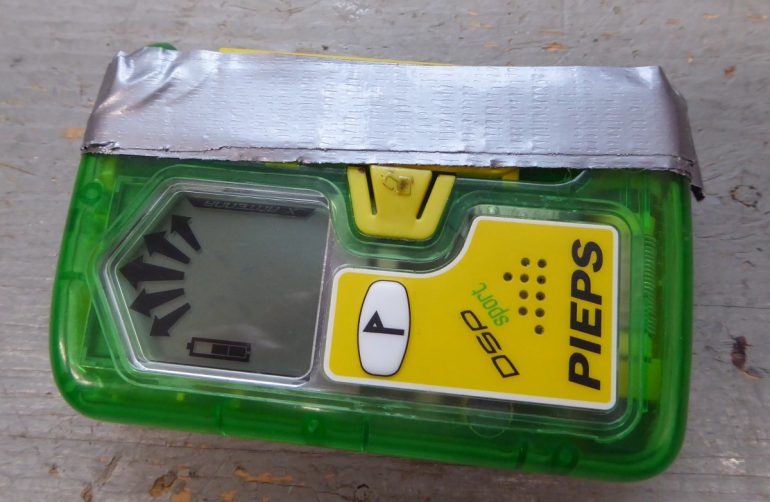Update: My son Louie and his industrial design friends have come up with a concept for a DSP switch lockout. Details here.
Considering recent attention to this version of the DSP (green “Sport” model, same switch mechanics as DSP Pro), I acquired a used but not abused unit, and performed a few instrumented tests.
Disclaimer: Please note that this blog post is personal opinion based on my own testing and manipulation of the Pieps DSP Sport. It’s somewhat of a review, but only regarding a few specific issues. I only tested one beacon, others could test differently, and while of good quality, my instrumentation is not calibrated. The beacon models in question here have been around for at least five years, may have undergone “inline” changes of both the beacon and the harness. Most of the issues below have been previously presented in various internet venues. I only seek to offer measurements, my ideas, and perhaps more clarity.
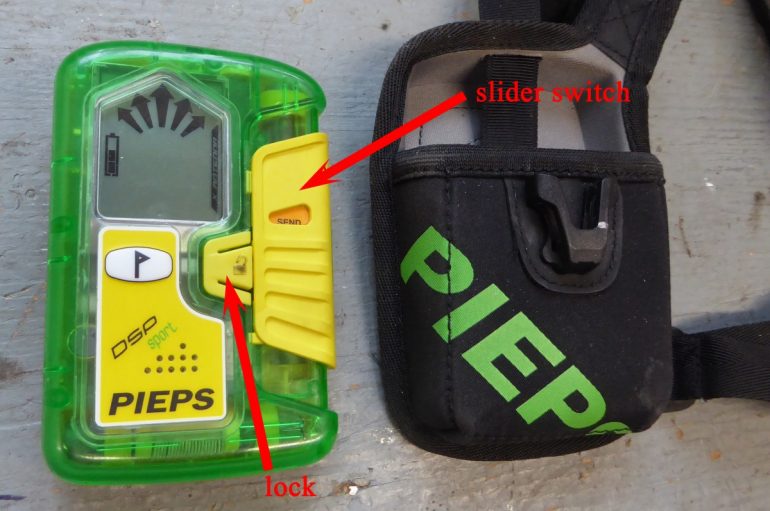
The object at hand, Pieps DSP Sport avalanche beacon transceiver has ceased manufacture, but remains available in retail channels. There is also a “Pro” model of this beacon, presumably with the same switch and accessories. We did not test the Pro.
If you’re not familiar with the Pieps DSP Sport, see the Black Diamond video embedded below, as well as myriad other YouTube vids. The issue we’re addressing here is the design and function of the green Pieps DSP Sport’s yellow sliding switch and its associated lock button. When the lock button is depressed, our test unit’s switch feels tight, though it slides fairly easily once I got the hang of it, (in fact it’s eerily reminiscent of working the slide on a semi-automatic Austrian machine designed to propel hunks of lead. Even the locking tab is similar in concept to the slide lock on said machine.)
Important: With our test unit lock engaged, with normal hand strength I could not force the slide switch and compromise the lock — BUT I DID FIND WAYS IT MIGHT BE DEFEATED. Read on.
The switch lock is a tiny yellow tab, a plastic living hinge that protrudes 1.57 mm and requires depression of a third — or less — of that distance to release. This is difficult to measure, I used a set of feeler gauges as well as my digital caliper to do the best I could. In real-life language, it’s sensitive. How sensitive? Next slide please.
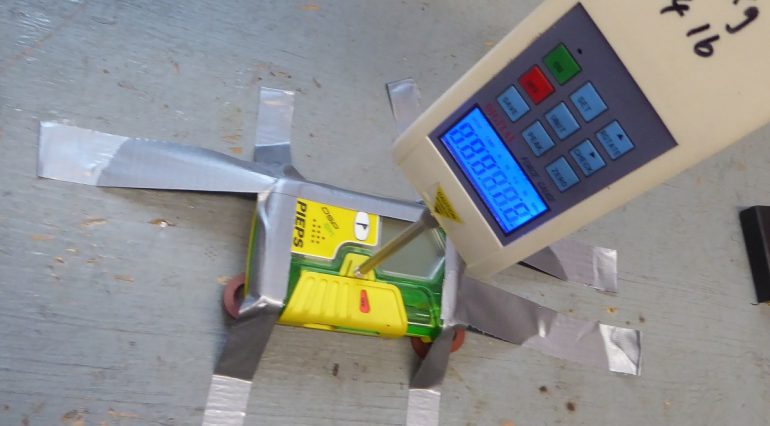
Force required to depress the lock button — sans holster — was difficult to measure, but after multiple tries I think I got close enough. Using my push/pull force gauge, it took 820 grams of pressure to disengage the lock, thus allowing the slider switch to move. If you’ve got a decent scale, try feeling this force yourself with a finger press, it’s about the same pressure the average person would use to give their head a firm scratching. It’s not much force.
Hmmm, it was time for dissection.
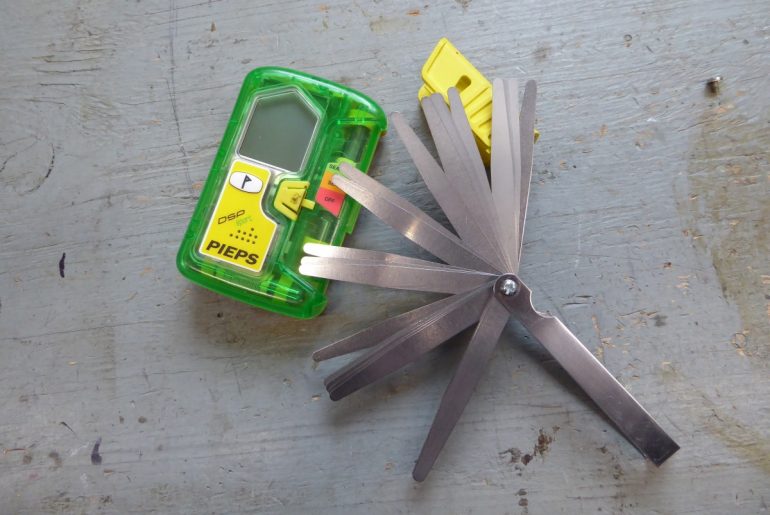
Every WUV certified testing facility has a set of feeler gauges to go with their ANSI approved pry bars.
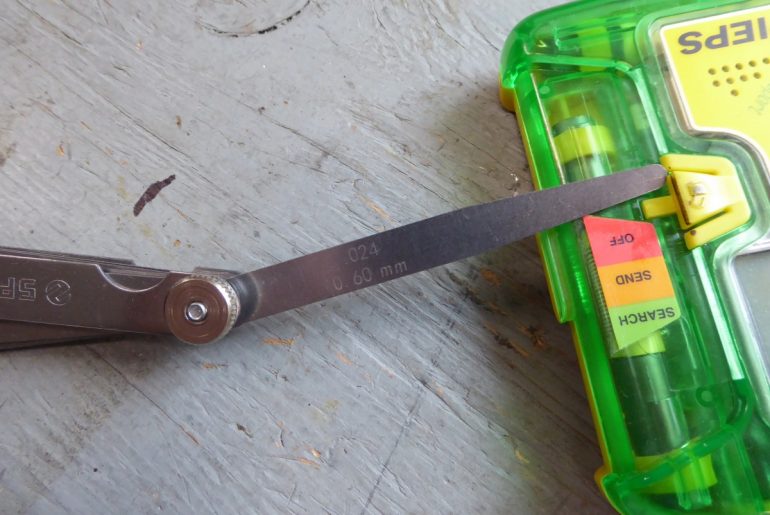
The lock tab protrudes about 0.6 millimetres, determined using my feeler gauges. That makes sense, as we previously determined a press of about 0.5 mm releases the slider switch.
So, in my opinion the lock button and associated tab might be somewhat sensitive to inadvertent presses. It’s not hard to imagine how this might happen in the event of an avalanche ride. But does the holster-harness help prevent that? My take is a big NO for the harness pictured here. An improved harness might be better, but in my opinion the potential for accidental button presses exceeds any solution I can envision other than duct taping the slide switch into the transmit position. Put another way, the button is perhaps a design problem.
While Pieps documentation recommends placing the beacon in the holster face-in towards body — “In order to protect the beacon’s display, carry the beacon with its display facing inwards…” — it is all too easy to place it face out, in fact doing so to me seems in some ways more logical, as it’s easy to see if it’s transmitting. But while the Pieps manual doesn’t mention it, carrying the DSP Sport face-out is probably the worst thing you can do in terms of preventing inadvertent movement of the lock and thus the slider. Check it out:
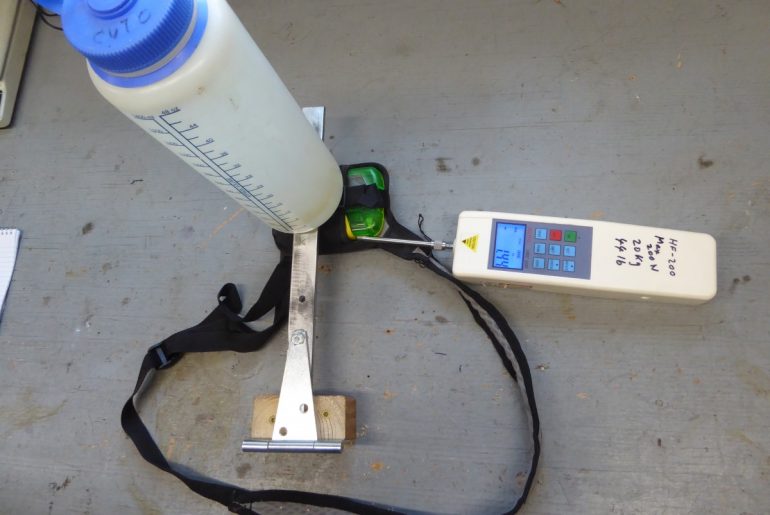
I took a few moments to cobble this little contraption. It uses a water-weight (easily adjusted) to apply pressure over the switch button in the case of the beacon facing out, while in the holster. (The steel bar and hinge may look a little complex, but their only purpose is to stabilize the weight so it presses on the buckle without tipping over.) The holster buckle is perfectly located to concentrate force on the switch button if the beacon is facing out.
It took 1,798 grams of weight on the buckle to overcome any resistance of the case and depress the lock. Also with the unit in the case, sliding the switch required 1,440 grams of force-weight (and that force was noticeably reduced when I lubricated the slider with a spritz of water). Again, not much pressure considering we’re talking about a device designed for use by an avalanche victim doing things such as hitting trees at sixty miles per hour, not to mention being buried under thousands of pounds of snow.
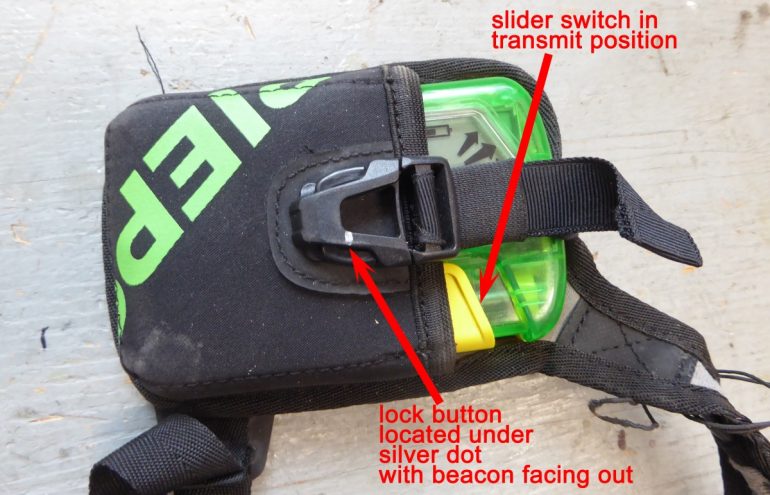
Beacon facing out, in transmit mode. The lock is located under a pressure point created by the buckle. More, the sliding switch is exposed to possible pressure from gear or clothing, or even the constant movement of the holster could gradually move the slider switch to the off position. Could this be a recipe for disaster? In my opinion that could be so.
What if the DSP is placed in the holster face-in (LCD towards body), as Pieps recommends? I couldn’t figure out a way to measure the button pressing force in this configuration, but by simply squeezing with my fingers I could depress the lock button and thus free the switch for possible accidental switching out of transmit mode. Again, the switch moved under about 1,440 grams of force-weight, well within what could happen if gear or rucked clothing were pressed against it during an avalanche ride and subsequent burial.
So, how about carrying the DSP Sport in a clothing pocket? Judging from the protrusion of the lock button and ease of pressing it, as well as the ease of moving the slider, I wouldn’t be totally confident of a pocket carry either.
CONCLUSIONS
When I originally tested the DSP Sport several years ago, when hand manipulated in my office the slide switch and lock strongly resisted defeat — same with the test unit used for this blog post. BUT with more attention to simulating real-world use, I find the slightly protruding lock tab, and consequently the exposed slider switch may be too easily defeated by possible vagaries of clothing or terrain pressing against it during an avalanche incident, or even during hour-to-hour use in the field.
Moreover, the locking button reportedly may crack, thus rendering it weak or entirely ineffective. I cold soaked our test unit to negative 3 degrees Fahrenheit and depressed the lock button 300 times, with no cracking. But, I did notice our test unit had previously cracked near the battery door screw, and the transmit indicator light. These cracks were present when I received the unit, they could have been from it being dropped or otherwise impacted, they’re worth noting.
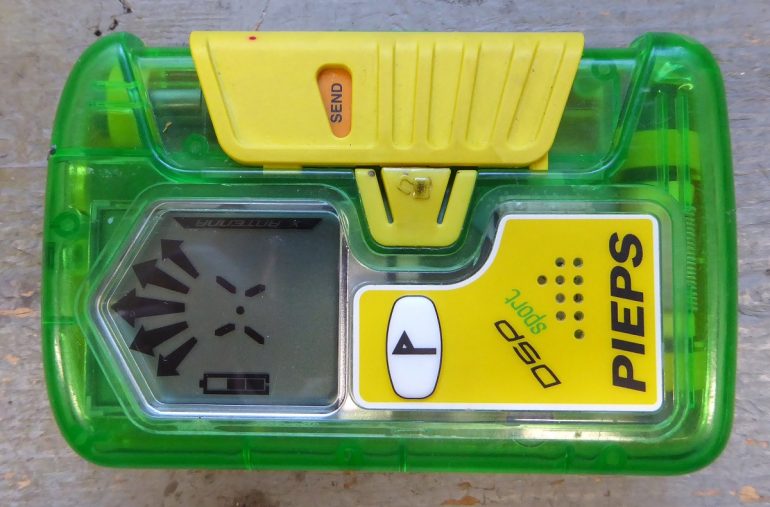
Is it locked in send-transmit, or is it not? In this case, it is not! This is due to the magnetic switches having a broad range of operative distance. Could this happen in the field? Who knows for sure, but while experimenting I got the nice elongated beep and the LCD display showing me the unit was in “SEND” mode, only this happened before the lock clicked in!
(Interestingly, I can place a magnet next to the switch, with switch in “off” position, and turn the DPS on. Thankfully (documenting all this weirdness is getting tedious), once the slider switch is moved to the “send” position, the magnet has no influence. My test magnet is powerful. I tried the same thing with my laptop and wall audio speakers, and nothing happened.
If you continue to use the DSP Sport, be sure to place it rear facing in the holster, and if it was me I’d duct tape the switch in the transmit position. If carrying in a pant or jacket pocket sans holster, again face it in, and again apply duct tape. Pieps is said to have redesigned the harness and holster, but from what I gather in my ‘net research, the pouch design shown in this post is ubiquitous — and if the DSP is carried in a pocket, there are still possible issues.
The newer models of this beacon, the Recon/Powder-BT, have a redesigned switch lock, perhaps for good reason. Thankfully, Pieps and Black Diamond (BD owns Pieps) have stepped up and will help save your duct tape, and perhaps your bacon? They’re offering some kind of upgrade, more about that here.
Lastly, to be fair, I have found that funky switches are endemic to the avalanche beacon industry. I’ve got my opinions on why this is, but won’t pile on any more words. Comments on!
WildSnow.com publisher emeritus and founder Lou (Louis Dawson) has a 50+ years career in climbing, backcountry skiing and ski mountaineering. He was the first person in history to ski down all 54 Colorado 14,000-foot peaks, has authored numerous books about about backcountry skiing, and has skied from the summit of Denali in Alaska, North America’s highest mountain.

